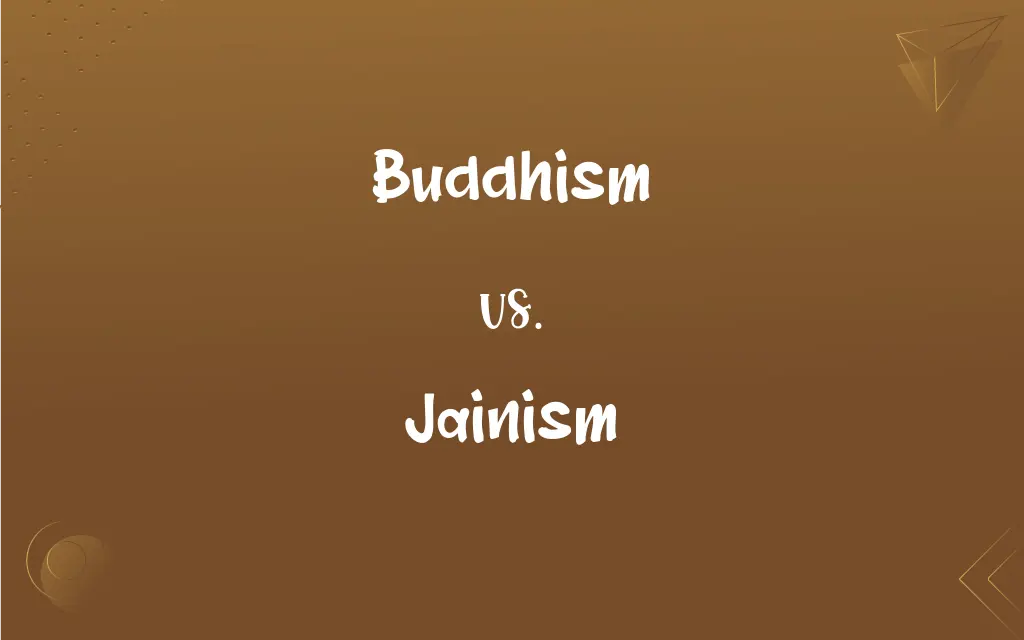Buddhism vs. Jainism: What's the Difference?
Edited by Aimie Carlson || By Janet White || Published on July 11, 2024
Buddhism is a spiritual tradition focusing on personal spiritual development and the attainment of a deep insight into the true nature of life, while Jainism emphasizes non-violence, truth, and asceticism to achieve liberation of the soul.

Key Differences
Buddhism and Jainism are two ancient Indian religions that have their own unique philosophies, teachings, and practices. Buddhism, founded by Siddhartha Gautama in the 6th century BCE, emphasizes the Middle Way, the Four Noble Truths, and the Eightfold Path as the means to achieve enlightenment and liberation from the cycle of rebirth and suffering. Jainism, older than Buddhism and established in response to Vedic ritualism, is centered on the principle of ahimsa (non-violence), truth (satya), and asceticism, with the ultimate goal of achieving liberation (moksha) for the soul from the cycle of death and rebirth.
Both Buddhism and Jainism share common ground in their non-theistic approach and stress on personal effort to achieve spiritual goals, they diverge significantly in their doctrines and practices. Buddhism teaches the concept of Anatta (no-self), suggesting that there is no eternal soul but rather a continuous cycle of rebirths that can be ended through enlightenment. Jainism, on the other hand, posits the existence of a soul in every living being, with the potential to achieve liberation through strict ethical living and self-discipline.
The path to liberation in Buddhism involves following the Noble Eightfold Path, which includes right understanding, thought, speech, action, livelihood, effort, mindfulness, and concentration. This path emphasizes moral conduct, mental discipline, and wisdom. Jainism prescribes living a life of harmlessness and renunciation, following the five major vows: non-violence, truthfulness, non-stealing, celibacy, and non-attachment.
Buddhism has a monastic tradition with monks and nuns living in communities, focusing on meditation and teaching as their primary practices. Jainism also has a strong monastic tradition but places a greater emphasis on ascetic practices, with its monks and nuns taking vows of non-possession and often engaging in practices like fasting and body mortification to purge karmic attachments.
The concept of karma and samsara (cycle of rebirth) is central to both religions, but they interpret and approach these concepts differently. Buddhism teaches that karma is the intention behind actions and that understanding the nature of reality through wisdom can lead to the cessation of suffering. Jainism views karma as a physical substance that attaches to the soul and dictates the quality of future lives, advocating for strict ethical behavior and asceticism to rid the soul of karmic matter.
ADVERTISEMENT
Comparison Chart
Founder
Siddhartha Gautama, 6th century BCE
Mahavira, 6th century BCE
Core Philosophy
Middle Way, Four Noble Truths, Eightfold Path
Non-violence (ahimsa), truth (satya), asceticism
View of the Soul
Anatta (no eternal soul), concept of rebirth
Eternal soul in every being, cycle of rebirth
Path to Liberation
Noble Eightfold Path: ethical conduct, meditation
Five major vows, including non-violence and truth
Monastic Life
Community living, meditation, and teaching
Ascetic practices, non-possession, and renunciation
ADVERTISEMENT
Buddhism and Jainism Definitions
Buddhism
Buddhism follows the Eightfold Path as a guide to moral and mental development.
He adopted the Eightfold Path in Buddhism to improve his life.
Jainism
Jainism centers on non-violence towards all living beings.
He follows Jainism, practicing strict non-violence in daily life.
Buddhism
Buddhism teaches the Four Noble Truths as a way to understand and overcome suffering.
Through Buddhism, she learned the cause of suffering is desire.
Jainism
Jainism emphasizes living a life of honesty, celibacy, and non-attachment.
Jainism guides her to live truthfully and without attachment to material things.
Buddhism
Buddhism emphasizes mindfulness to cultivate awareness and compassion.
Mindfulness meditation is a key practice in Buddhism for achieving clarity.
Jainism
Jain monks and nuns practice extreme asceticism to purge karmic attachments.
Ascetic practices in Jainism are seen as a way to cleanse the soul.
Buddhism
Buddhism is a path to enlightenment through meditation and ethical living.
He practices Buddhism to seek inner peace and understanding.
Jainism
Jainism aims for the liberation of the soul from the cycle of rebirth through ascetic practices.
Jainism's goal is moksha, achieved through ethical living and self-discipline.
Buddhism
Buddhism explores the concepts of rebirth and karma in the cycle of samsara.
Buddhism's teachings on karma influenced her to act more kindly.
Jainism
Jainism views karma as a substance that clings to the soul, affecting its rebirths.
In Jainism, rigorous ethical conduct is required to free the soul from karma.
Buddhism
The teaching of Siddhartha Gautama that life is permeated with suffering caused by desire, that suffering ceases when desire ceases, and that enlightenment obtained through right conduct, wisdom, and meditation releases one from desire, suffering, and rebirth.
Jainism
An ascetic religion of India, founded in the sixth century BC, that teaches the immortality and transmigration of the soul and denies the existence of a supreme being.
Buddhism
The religion represented by the many groups, especially numerous in Asia, that profess varying forms of this doctrine and that venerate Siddhartha Gautama.
Jainism
The heterodox Hindu religion, founded in the 6th century as a revolt against Hinduism; its most striking features are the exaltation of saints or holy mortals, called jins, above the ordinary Hindu gods, and the denial of a supreme being and of the divine origin and infallibility of the Vedas. Also, the sect comprising those adhering to Jainism. Jainism believes in immortality and the transmigration of the soul. It is intermediate between Brahmanism and Buddhism, having some things in common with each.
Buddhism
The religion based upon the doctrine originally taught by the Hindu sage Gautama Siddartha, surnamed Buddha, "the awakened or enlightened," in the sixth century b. c., and adopted as a religion by the greater part of the inhabitants of Central and Eastern Asia and the Indian Islands. Buddha's teaching is believed to have been atheistic; yet it was characterized by elevated humanity and morality. It presents release from existence (a beatific enfranchisement, Nirvâna) as the greatest good. Buddhists believe in transmigration of souls through all phases and forms of life. Their number was estimated in 1881 at 470,000,000.
Jainism
Sect founded in the 6th century BC as a revolt against Hinduism
Buddhism
A religion represented by the many groups (especially in Asia) that profess various forms of the Buddhist doctrine and that venerate Buddha
Jainism
Religion founded in the 6th century BC as a revolt against Hinduism; emphasizes asceticism and immortality and transmigration of the soul; denies existence of a perfect or supreme being
Buddhism
The teaching of Buddha that life is permeated with suffering caused by desire, that suffering ceases when desire ceases, and that enlightenment obtained through right conduct and wisdom and meditation releases one from desire and suffering and rebirth
FAQs
What does Jainism emphasize the most?
Jainism emphasizes ahimsa, or non-violence, as the highest ethical standard.
How does Jainism view the universe?
Jainism views the universe as eternal, with no beginning or end, and governed by natural laws.
What are the major vows of Jainism?
The major vows include non-violence, truthfulness, non-stealing, celibacy, and non-attachment.
What is the significance of meditation in Buddhism?
Meditation is a core practice for developing mindfulness, concentration, and insight.
What is the main goal of Buddhism?
The main goal is to achieve enlightenment and liberation from the cycle of rebirth.
How do Jains practice non-violence?
Jains practice non-violence by being mindful of their actions, speech, and thoughts, to cause no harm to any living being.
Are there different sects within Buddhism?
Yes, major sects include Theravada, Mahayana, and Vajrayana.
Can anyone practice Buddhism?
Yes, Buddhism is open to anyone regardless of background or belief.
How does Jainism explain the concept of soul?
Jainism teaches that every living being has an eternal soul that can achieve liberation.
Do Buddhists believe in a god?
Buddhism is non-theistic and does not focus on the worship of gods.
How does karma work in Buddhism?
In Buddhism, karma refers to the actions driven by intention which influence future suffering and happiness.
What is the Buddhist view on the soul?
Buddhism rejects the notion of a permanent soul, advocating the concept of Anatta (no-self).
Do Buddhists observe a monastic life?
Many Buddhists, especially monks and nuns, live a monastic life focusing on meditation and teachings.
What rituals are important in Jainism?
Important rituals include Paryushana, a time of fasting, confession, and forgiveness.
What is the role of asceticism in Jainism?
Asceticism is practiced to purify the soul and detach from karma.
Can laypersons practice Jainism without being ascetics?
Yes, laypersons can follow Jain ethical principles and rituals in their daily lives.
What distinguishes Jain dietary practices?
Jains often follow a strict vegetarian diet and avoid eating at night to minimize harm to living beings.
What is the significance of Mahavira in Jainism?
Mahavira, the 24th Tirthankara, is considered the founder of modern Jainism and revitalized its teachings.
How do Buddhists achieve enlightenment?
Enlightenment is achieved through following the Noble Eightfold Path and practicing meditation.
What is a unique feature of Buddhist teachings?
A unique feature is the emphasis on suffering and its cessation through the Four Noble Truths and the Eightfold Path.
About Author
Written by
Janet WhiteJanet White has been an esteemed writer and blogger for Difference Wiki. Holding a Master's degree in Science and Medical Journalism from the prestigious Boston University, she has consistently demonstrated her expertise and passion for her field. When she's not immersed in her work, Janet relishes her time exercising, delving into a good book, and cherishing moments with friends and family.
Edited by
Aimie CarlsonAimie Carlson, holding a master's degree in English literature, is a fervent English language enthusiast. She lends her writing talents to Difference Wiki, a prominent website that specializes in comparisons, offering readers insightful analyses that both captivate and inform.






































































